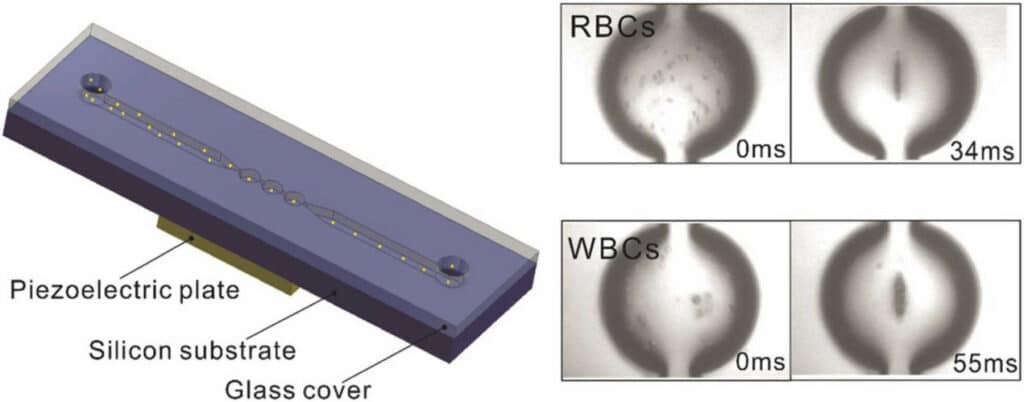The ability to clamp, separate, filter and aggregate cells makes cell trapping crucial in biomedical engineering. Acoustic trapping has been one of the most popular techniques used in biological research because it allows contactless and biosafe cell manipulation.
One of the forces with this capability is the acoustic radiation force produced by an ultrasonic standing wave. A research team from the Chinese Academy of Sciences‘ Suzhou Institute of Biomedical Engineering and Technology (SIBET) has created an acoustic trapping chip that can trap cells in three dimensions (3D) in a continually flowing liquid with a circular resonance structure.
Scientists created this chip by attaching a piezoelectric plate transducer to a silicon-glass bonding plate with a circular cavity. The cavity works as a resonant unit, excited at a frequency of both half-wave resonance in the central plane and inverted quarter-wave resonance in the depth direction.
 Schematic diagram of the chip design and its trapping performance on red blood cells and white blood cells. The cells aggregate to the center of the circular cavity within 60 ms. (Image by SIBET)
Schematic diagram of the chip design and its trapping performance on red blood cells and white blood cells. The cells aggregate to the center of the circular cavity within 60 ms. (Image by SIBET)
Ultrasonic standing waves can be further classified into:
Standing bulk acoustic waves (BAW) generated by a bulk piezoelectric transducer or
Standing surface acoustic waves (SAW), generated by single-crystal lithium niobate (LiNbO3) etched with interdigitated electrodes.
SAW can manipulate particles with a meager energy cost. Still, because of its lower clamping force than BAW, it is typically employed for sorting in flowing liquid and particle arrangement in stationary liquid.
On the other hand, the acoustic microstreaming vortex can also trap cells close to an obstruction or microbubbles. The trapping efficiency can be increased by changing the design of micropillars or other barriers. However, some traps are difficult to release particles from, and some cannot provide a fixed position for trapping.
The trapping force mainly determines the trapping efficiency. As a result of insufficient trapping pressure, particles are typically caught in static fluids or fluids flowing at prolonged speeds in most earlier experiments. High-throughput cell manipulation is crucial for many biological applications, including Raman identification and nanoparticle capture, although doing so lowers both trapping efficiency and throughput.
Scientists created a standing sonic wave in the circular microstructure to clamp cells in the middle of the chamber. Cells near the microchannel’s bottom are connected by the radiation force produced in the depth direction.
As a result, a 3D cell confinement is produced through a unique set of microchannels that are only activated by one piezoelectric plate transducer. According to experimental findings, the chip can trap micron-sized particles traveling at a speed of mm/s with a nanonewton (nN) level of force and a millisecond (ms) level of time.
The chip can be used in a number of biomedical engineering situations, such as organ chips, cell culture, Raman analysis, and nanoparticle capture, thanks to this non-contact and biocompatible trapping technique.
Journal Reference:
Ce Wang, Shuai He, Jiansheng Chen et al. Acoustic 3D trapping of microparticles in flowing liquid using circular cavity. Sensors and Actuators A: Physical. DOI: 10.1016/j.sna.2023.114698
>>> Read full article>>>
Copyright for syndicated content belongs to the linked Source : Tech Explorist – https://www.techexplorist.com/acoustic-trapping-chip-provide-3d-trapping-cells/75465/#utm_source=rss&utm_medium=rss&utm_campaign=acoustic-trapping-chip-provide-3d-trapping-cells






























